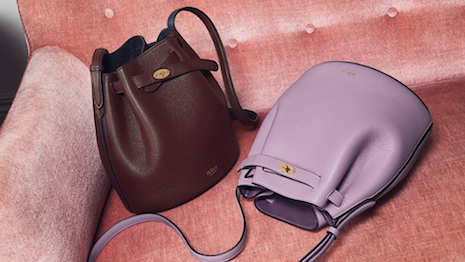Bolstered by revenue gains at companies including LVMH and Kering, the stock prices of some of the biggest luxury companies saw significant growth in April.
The Savigny Luxury Index, which tracks the market caps of 19 leading personal luxury groups and brands, rose 12.1 percent last month, marking the biggest month-over-month increase in three years. Following challenges in recent years, the luxury business has been rebounding, and the stock performance of leading luxury players reflects this upswing.
"We do believe that growth in luxury is here to stay," said Ludovic Granchamp, partner at Savigny Partners, London. "Brands, which command strong desirability, will do well."
Produced by Savigny Partners, the SLI tracks the market cap of luxury brands, comparing them to the MSCI.
Luxury lift
Kering’s stock price rose 23 percent in April. The company’s revenues rose 27.1 percent in the first quarter, led by sales increases at Gucci and Saint Laurent (see story).
The group is currently focusing on being a purely luxury group, selling off its Puma and Volcom businesses.

Cara Delevingne for Puma. Image credit: Puma
Meanwhile, LVMH’s 15 percent rise in revenues helped its stock price increase 16 percent last month, and Richemont's stock price grew 10 percent.
Swatch’s stocks benefited from a weakened Swiss franc, rising almost 14 percent. The exchange rate shift holds potential for the Swiss company, which includes brands such as Breguet and Harry Winston.
While Moncler’s results were not announced until May, its stock price climbed 21 percent in April in anticipation of its sales growth.
Even though the overall SLI grew in double-digits, not all companies saw share increases.
Ralph Lauren and Estée Lauder saw slight 1 percent hits due to the expected impact of interest rate increases in the United States.
Mulberry’s share prices fell 6 percent. Savigny Partners attributes this to the low number of shares being traded, since 90 percent of Mulberry’s total stocks are held by three people.

Mulberry wants to continue UK manufacturing despite rising cost. Image credit: Mulberry
Things are looking up for luxury in China.
President Xi Jinping announced he would cut import tariffs and allow brands to invest more in China. This is particularly impactful for the automotive market (see story).
The country’s leader also plans to crack down on intellectual property infringement, a key issue in China for luxury brands. Many of the fake Web sites selling luxury knockoffs stem from China.
China is one of the key growth drivers of the luxury market.
Another key factor in luxury’s financial growth today is ecommerce. Categories that previously eschewed selling online are embracing the sales channel.
In April, Net-A-Porter created a hub for fine jewelry, which retails brands such as Piaget and Buccellati. The retailer anticipates doing 100 million euros, or about $120 million, in sales of jewelry and watches by 2020.

Net-A-Porter is retailing fine jewelry online. Image courtesy of Net-A-Porter
Chinese ecommerce platforms JD.com and Tmall are similarly courting luxury brands. Alibaba-owned Tmall introduced a loyalty program for its Luxury Pavilion, while JD added Oscar de la Renta and Mulberry to its roster of brands in April.
Watching eyewear
Savigny Partners notes that as luxury conglomerates own more of their own eyewear development, it could put pressure on groups such as Safilo.
As eyewear becomes a more important aspect of the fashion world, luxury conglomerate LVMH is looking to strengthen the significance of its own eyewear.
LVMH, in partnership eyewear manufacturer Marcolin, has dedicated a mission to beefing up its eyewear category. Stronger collaborations, better production and quality customer service are the mission states of the company named Thélios, which is launching a new Web site and headquarters building (see story).
While LVMH brands do not have to partner with Thélios for eyewear, the joint venture is set to become a preferred partner of the company’s houses. Many of LVMH’s houses, including Dior, Fendi and Givenchy, have licensing deals with Safilo.
So far, these moves have not seemed to dampen Safilo’s performance. In the first quarter of 2018, Safilo’s sales were up 7 percent year-over-year, and its stock grew 1.5 percent in April.
However, over the long-term, Thélios and Kering Eyewear could force the category’s key players to adapt.
"As Kering and LVMH onboard some of their brands, former licensees will indeed be negatively impacted," Mr. Grandchamp said.
{"ct":"\/sv8dFO7gnfQDd9RTiu\/E+QgqnaVSVUIgKL1wHET2wni6r2T\/bGOMT3Nb0KcFb958p3kUbozmp0NoFZSwpy\/2yrfbWAFjnAMqTFsakrdDNntNLfI0CWAnHt0Qp\/2A36Pxo1ImdDP824\/5naOmFuswsQLgm7K9m4vhJiofjKFxwCIvyByhCnqQjUrfLNjC5mbH0aADkhYVa+a8T0zMFONk18AfhlbV+Np+2FzfU9PdQR4f+REnFS2p1uxv7wm2dxxGtmEXkzCAzvMTXaB8WotkbyHamSKFF6txBuuyRZW8xWM7hqH051yPMiTSW9ETO1VUeaSrk9iPDgdKzAvOpbuE1\/LrZ4EOUAN8mNjAQlbDdblqDnqyi89COfPJ9RkNkHO9tI2SJ78i4EaGLvmAp2AZtJtff4fIQhA1aH1UuKnxoeVNlsllkRXOXCrkRBPJb8e8GPgrL1ObcDprqA6YJ2LyzkovEJLrFD9ZmyrsSEVfXxj1Qw9qrKr1eLEHNzOVyRVk81g3qf3\/i9EzYo4y1YhmDAyRZXixs\/FzetK6OmcJlZjPoTgLZqIqiaGJa5hFAK0O4lkcQhMVyV7XH7T+8m1S8VlDs7dBqLA3Apgmjb8Yyy8GMgp1aFtAABGe7gOSw1vubNLzHPG6sONkf2bFY2Adcr2a5QNs+b2Vz2XjBOMTo+EwiNYoQxWAkya9oAa2OvfhU5Hkjj\/EOv9fhbGKcY+ZiPYdZ0yg6dZvYFJE7D8kMWfCuezrrMJkfJxoT2wIx9LqPc1fv0NB7WaRsZV378Q1hDhmi7LGAK2c\/3R9qVTkYqDr3a4Rw9J5CtMuXnSebgRij\/kS7suv2tWdx8nQbMNKG0\/z7ULhOwXwkqXp00srjFx3HWJnNA+I0+21tZ\/n85yA9A6st51CHJx4LFAK1POukoxfm4XzlaCAgdLJ4zlpqVPLuI8UonYL3qjaoK8XilGuuaZnbiDBcdExg\/HnQRaSVZD3QFJxzizd0uyc+uRVkrmYuE9oeMtkkcBjQpsdYAiRNMHQS7jB2fY913bdcHKffDRDG6fXpgLlp+7BvPjFH0liS9NjBwZwUpzMbtz6BkvGev9Scm\/9pfUqX\/nQeF5b6Fy5y5QJ2RM1JUdY2MpRVnx2nsR7sgfXnJI9xyY2b3ePln2hbCZdrBI\/3hWKhpCLr\/qe\/LJmSNnD\/YmLyCmzH85sbgwFFlJxue5k1X1aRq72nIQ5bvjss8t03GKUI0jhyTY6IoIMRJmsjHRqlLfV8umkmcueX0i\/xF7UouApDMoZ\/Boc+D5odFekK4WCV+h1KGefxNr6Ee42P8syr7vg+lODPpGXIrIHUMyDXY1PH67su+QwCvN4gHk16QElv\/scpSVvKhOI+t+vt5WNe\/Z5y6dYpwgJIFW8wzHMK9vb6iRuu8yYRkltuCCiGeTFeA2t4ueyufaicqKeU9ABr3oMsUvXPN9y28EamnLCitTqW1vMyk4VKFI+eh2bkLf3OtJfjh47kP+Wd848nzkl7Ljg63MflM4DoFRAOgsO8LN09FLsckX2Fa9pSkbNSYNfwLb2tyEo2fCCYNnX9tZ8OcpmDq8zYVD5wvaekDviX0xtdk2ypoJt\/dYPThwH+a5xrKpk31YyCXHlYxDfxZ0JlGs4zvWPnsZTfosph30k7nTaEa9ReZZd1jMDWpwo9iSfgApqWYG26CBTkV5ZPs1o7IfutJyflBuk0GzGVTNpQTtgebX9yDd00yes20mcy5KvAuJZH8tjhDlwuURf+4Ymg+KqYx2vw6GcM49SnriSP7+3M8BZCNHiGgznbnFhXeoD2N1Pul9ItJCPtP1LeXUAoK7LJDuCtLubKZ6cKapuBdG2le3JxwLqEqeOS4TJkkW7jilLXs1+u2nKUXYKeORgLAPSx6kl7JN6PUP8fTYI0N8q8y8pU2bidX6Qy+LtyC5fw1Mw\/xp2QpGbHEUvAG6awEBQ3JI53VQn6iB5XFZK+fXXAzvVREiG2duouCEtkr\/4AA0WO2bC9HKjVIgeYb6NXpcj3M9ROU0pJhxvS5FLU169MkJk3vF4J+G3DmyhxJIChYkKtk9paq131pYRw8GpziDFUFli1QH9rUdKQ023M65T4MucRuH5r5onqh0gS86QahROEYAI+WaheFF8tb\/SUNQNqe7sx54JV5OE+RkODMKu7X0rDiWPt\/c9EbKYxDX\/iMkVn85ekq8Z0M46LV3x1Tw8IBcgrNUYxx1cI56D5FMwannsS2gIGhTIWCddWcw4Qh7Ge5B\/3CVvAQZcyiddEba0bC1gM5j\/A\/FJ+gzie+mjPsCDzznWKFCeh7EEuPE8GL4ARuuTHqyqyTPXSr6vMrwlYg+2gcta5hVBV8iijvcKA9QN\/Cs6F0IXx+8vysIeVLkibo1nUloUHhgOsswZnemccej50hL7v6HN4XdH0YjHySXb6fvBH6N08k5Sw83JQqICSCYYtula8Dm4+uqkNvIeIGaf40BNtzPTNnYN0C\/gV2kwtIzEh2caGVZto\/JlxlRKkbiEpM39OZYUtV3ohQh33saBzLDcQkGfqnNe1YQHKUk6ng5OG+VlfXlYWfTrewGoDeMLyPzq3xwVsEwzpFU0dfcj16Ra8fswJPbeJ4Dn17LDv5S1ylyIb7aQGyU5+ZjSes89HcaOu\/\/AeBEr7oXWjl6pyNAtdEqGLPALSdWtjRjK3Ai7zJ3MvDZ\/++TWiobk\/ApS1XKhQIfBMZSnwDa8+0FgAh\/Vw3lZbrjKLg9dLoBV3A1MRBCd11YwuoVvKflvs7YTaL4HhpPvNo3MjdnvV1f\/D39p0QDC6KUCZKgKp2tUdgBpcvv4W4ERL1gqk93RBMLazuA8WOfC0Dmtq8qxohqyPsOgzTOETSjz5+2SPn4ZwA2qSUk8nAtKFv4T1rQZCmgZmVl9FtR5YMpafxmjaooEAxXuQwIZikdf\/ui78RPSisANDN5kFT5E1JpVPkU0V1KakdfIMwFXOdlLRG6SvxLK\/o+mBR4m25MBa13rSBV7CtiTM2Zz9K7YD90I5cwgFHceR8LtEWz+asjSxxeBnh3I6vEJ57A2IsHSUKjecuH1lqzvhFbbrd0yItmsDGOXpisNmxXdOOYrQLB1x\/W7CfXyzhspjbKol7lKOMEge0gRR+MzHpCPBoSFnBDmNUUPUljkKJ\/cj1JS0F0dBQSnlkpQeXLUozgGpJwOoHLn7pzDGgYKJzckQ6bbpSLZW6ZrNy0BRK6Q8\/2i8Hwbst4CB9YPQFLHmj2ATgvj7rKXCwKI9xa2bPBxkiNHpDcvJN0o4zx66iKY5iKbaT2DTZTdBbTqY6OCGyDuG1xvtL6pkGkXANC+OomUEmbIG0Igb\/YJUbBmskmsLXCi9FcnsSV70vIAz83+qdTxEQXYaPMp70HCjx4GlXlpyHoVOyoRX310D3j9oxAVFMsbXzWnci3Bz3P2s3O8RjOSDAvI2SSkg8huJGcuDr4XQnpkWQXfjwJTbx\/UkLaC1n4jZfg5W\/HozrqKMYROEjijibK1nVW2pa\/Zy2dgI2SBNdjd1iWgrh8T0D+64TG7bBuOqT4EB9ntFVL\/Qfra\/ZhO8B637\/Ti9kgygXTNV9xy1BwzDrWxY9R8V\/hBuI+b5Y4cvAX+UQ8WovVk18MjNiLiK4qnH5KrHCHE3vdTW0B5o\/nT\/in\/A0yq\/9VYkQ+SAT1vlrcx3tR3h0RE2VT87eVuIljMZ4HIDtlaBlssKshdd25JPVoshVm0\/Dah5ocdbD7OTnWaphIxY7t5zLSP6HtS1YHL8Bu9jigPlJHiYaa4r6WR5RoBM9HHO2MNnS0uzvG4axQgrKt9ERKvSzuDO8jqO9SHJrasOtCFjNEjYSUqmVctUGSsRM240+js1rTp1F7Bv9Hz++Q1+TDgt9jKtdOT4ngIv8WdbVxLp2skYU8HRkVQoxsQQjpjD8Akwg6yz7bELe5qgkd6d7XSG12f9W4tTPF+LIs5m1X+g6ShQ5xm7hj1BRCY3QZ5vxnhvss\/bOdm2FDGW9qwNNaNmHTTNzji5r6PuMqctsMHi9kVrC0ZlNhoBSI+MWQLbNpPNoC0Q2Imci9Z0HYe\/YAxtSFYEPfLYkTOPOqktcwIfNMBd8NDcJYPsX0vEPwtNg3gqdKyADIEXTHN7PcQUTDVhT0lwKoNjDTYnTr0varx5fXwDqjl3Ro3l2cGJaqIFGEtoZz0srOfDv0SoxMXxyQQEsPMAnlLp9i8v8g5ya44dEqUeOy04R0uESFqg8gUjo2WEr0yQrOEgOyqKV1harpLy326jy\/gVxga0ji66k11kmA2kIZ15we7XVabGF2dweovM7lkgb8+3itAG7sGGYk+5Yv9hmrWHujcnaBwjVGOfqZ5vhQ4YJTsyE5lmLfQF\/k0UEYVaIY2sNLj1P2hf7jcNvrVVP9DE6oPZpp\/mTvRH0OGvjuldhvBVtBy0A2HU1WYu2UUQPB\/\/CsofBxfV01QOGlgrM4y19nFGPFgviB8\/qadYMU90Bozm+SFyFmTQ\/M8onFm5I8fHw\/ShpP9BDerQHqK1Em+DF+2PiG1HBQrHEobWQrX5Cj3adVNTu48kgS6ZrP0WXaUfNeHwfY7iBeQeUZwfdwe5R68te6Wk\/Nwa1feURIBsoZXKiCqp0rQYXy7PwEK2FQDXX4EHeDuR1gzE2cEzsGgZQZSEQv2Kuz4Fcffmxf7H8OWnO8fq0A3VPNq+V2R\/aAAPnmaZofpFwW0oy\/zbQQ06Ux7tH0RNo+VcoKlN\/sQUTB5oY6BoZ0rE0vfYk062SXJk00PlZx8j4vfZeA8i5Z\/wwLf5+vlrh8txK1ZgfW+GrX96qiZN4HG9RIbWA\/T8q82e5MedxAzXuki0jO\/MP99qhpYVRa4vpksc5lQI7lYWgyhQyPHIDNiCyCLjnFmPpLxMiZNyXMXC9TM34DtoIN0zBLl4FgSny8Vgu3f\/3vxjzoTuUZ\/XBq0Ae0hMR\/SdJLZ4dSHvytv63dr\/3+E2WifhN6jzHfCtTOE\/\/1QfoGFlWpMGSjqXSrZzMH7OGY02fRIbAuOBm8RHcG3eBc19rBNS+8z42bj5DLabBqQDalnISubP0z5r83c2dHfJxe\/li+vQ0O6KuUlAlBf9XyJecsRWSgaGPYtpJpAC7I5naZJNxuuiKKK4kQou6OD3NQOONqk6VcEkZ3H2QgY7kaP0ve9knGzgktWsHTd1oSiu\/0pNXWtJ6SC72SpdAl2SZgTOoA5ZEgSr8xH4z\/nNiu0\/uR2EVyR8PDOjEfjKSYAKRCIEivRu4xV06YvdyUtFKls\/mnqN3AMuJyffnXKlYkbXpSR1DA2qUhZ4jYu0pfnP9so6xVDFVultxIM80uaU8MhOfY1mrVn\/uzbTtxhyk5OoQ6qxbaG8efT5B0N0FuCBIhBkv5JYAVhK0pR0U0bY0\/DWPLum1hWUoNvMkYYF23ZaKB9xkAVlU5cNPDzF\/6Uar72SXrTqnVXIPgI+p5F5h8qjsSHqa83omCd0rwS++h0pA7wfzFH7iNQSHwx4\/G1bBC5XxR8GMPIsIHFIjfYH46YJM\/UQy\/hE3A0ueXHvx9MKJu9fMA5E+xTAJN3H2TbVI26UmxAtkWByjvizwhj\/R57mfJ75pcM6WwpWKFmuREGQtylH6TV+zIgHlpyu1dM1Rl1yptrjnPz0lrFTYwi\/clLCy5vVJcIqgKzx2lgb0laDWgzyL7d6oq0yLu2KrRBMem+9qYwFCjLJ3YzbNFMuBsCa15U9ru78SEsOeVo\/wA9VY0Z5BikCZ7DWcfpJJAQL4iX4AB5eTMtwQwRQcUp43WpHKvneeGlhTGB9hNSPZZR1sd4U63BLzQMhbr71GyGsL4hRQr9LQHOf9PwJv7HTmfmvDfNgTOXrA\/0AaIUiQHDokGVa4ePlPBX4zNjExIZJ9UoSrxYG7QuwRVun96wQJb3rtIwYD0NcuQ7Oenh+Fsd4hBv5x\/0fkWhathI3O6I1KPzn6DEAcj5nh03oKKf0aQ2jBliW0SH+L+CqYSViDPaBrIXC5a36CXNi7Kh7ljKTOoi\/H4epqxSKEU5gbxGPKdN9r5V55UdXVJU51J36wh8Xi54hpBIvBR0nG4p2lo4VC7KQFQ6ovG2jndEHtLK+ZfqLOyTrZv4QkbuF66TIM8k6cIH6y2m4fFxQH\/wZ6zDa8iXTY2s3wqaTlj9rGvnxitH7Vu7bs65TDsIVAWfpsyVjsynwmr94\/mO4a36uO9n6UShQFv2codAVQBFRR13YBE3tXXbpW96ksCcF5qrT9JgiFiRufmzFhwirNhC\/nL5Gdi+Ce2BcPzxXv9Eg5TeFppTmckU2OD3+0NdZvHpqQmzvsFbJHVY6WcRca6TTtu\/qbvKOnDVzWhG5Ezc5HLHHUMRpD1lCEypmLs21DyE2LF8Kchof+NftQi6WpOIQDpzZO9w15mjVufMyMHLJE0TJCkzP+Xzix195SQ3SluQqWUpV\/7qTr4bQgeFFEsXSyiOlySpuU5VD7oeicGn4+EseARifIyCOq+Fq9WgOOg891MV2X78fZ4znPOsb5yoJhyv0Hr0myfvZjEDMZpo5TL92uomi8j+z5qLsTn51ZAaEbNNTW1jcBRprGMcRiWXX2CR4VNO\/OtHPFMymAr8VUUCjGpF5pzEs6gt0XPocmcrBpIUfxmfibSPvhESl4HickS01t+2AEthQhMoaayc\/Kj3wt\/KEEFEi9B+X1m2L+RmCPBNq9\/r2lSdIWvRwhcb4ZRMw3FlKxxN91pnTIDClgfuq7gbx8pvWhEhrGoerFPHSux9fDtHy4HoHofA9tcDvmZmY\/8pQLI4iRKbi4Zn8aN7fbs\/QjfF\/xS2hmgw3sQszJhzRjLJTIzF2f5Bw\/fmOc0nvZZK+YcScUC5S3+IiQbvuqav3Yw5OMyvIxhaGYgvlTTSBH9IcvkoTv5CyINlzHwowmAURv7Z0GPQha77FckC9uRw31W+t+lYGQplrufI157U5wY1Ww\/mS8i9TskQgKjWwgitRe7HgPhN\/BEGKdM69JoncQ4OaDrQHqZhtfxfEqFjctZnVZwjxUi+Juvb4WfTPBHqem+ouYYEyQ9TQIogxPPGx6rz\/NINydq+5FILk5tfAy6gbPdJ0o4Kczs0gNKBQ7f2fVKka1IzPi6GuClHZZeIJxUJzx69LznKGuSMw6\/LU4iBgjme2MeHHgmKlTVH5s7Z+3ywhvXtCwz68BNXVR7qdTfMEgcM6cQ5PHQHvgj5qViR1ChX9Vu+5mCERjkFB0kDeOINJ\/OZuQSb8laL8FH1W+0p7dCqcluLROj\/h7KPGQjHRoFXmG0tzfCKarimLc8PGrkWjqtlfWGaHvmB2AL0BL4VKPGecY9H50xMli+BE\/dkCDe\/43qr5VZRfwT0kTDCyRnmOPnz\/mQN3GW76R81MIeLZtc\/W\/yxIOXkp7Hcqr14qC5h53ywN0CeAfS5VqY27IGBko06P01eJq\/yccYqNlyHisagSl94R\/RW20JMPV4KvlQUWOwSp88vC9EbPCu\/PBOd6jOtLO6IEpxu4F66ynNgJiv1BdsZYVfTcGityN8uqmkmL9NuOI3P\/gbA7ymWITz\/Jg4EeV0rK6GSaXpoK8T4cUsuQTBEJluEd0CNAsaESomK6nGHSYbMbZcjyo4VswIi9SEjzvn3p3WPbt+LsOGJy5j5tge\/dKw0RRQl4HIQupDaZ\/+yVGvNwBMHbtHl9+dqen8nU4PQ\/stcbDCc8lZZi2gKJBY2f\/1rjsJnPyfMowDIJpzug5wSOHkvBpbLtc63Ekz5r9FkZid\/UTDDkkj2ETH5nJt7FY8p6dudf1RP4rDK+8TI+3L18fhmovlEoAEdMT2H1YaQbFVie\/66i+ePti5uVh1AgOPmKtc7wFj3kXQBiEUVj+RhMUacQeQcoYK2820SeYRFQMXRbJrCyhhzXbQ3jOk504hmQbccx\/MrCaQuunXJmgHrJT3kghBqjkZwh8kw7VvMulZcfoFy9kVYANUdkbEaLGlvhO0ayG\/ZO0xffbO3jpKKracJGHffoVscBMAJNka6XFp8iYGy7O2jpWd0tba+B3MLkDobYX\/sMwB6dmyjlRII30P1VlV+eSkQm7tUk7PLZJ17nDxeJaRaN20GK3OQoI9k9gb\/7i+yE37v0OJg8lDQl7LfG8dgZUyQ67kucFItKL1eQ+gGp8S8AM486AIIS2TKFo1ti5HartP5Kh\/OsgDqJ+Dpjh0\/zOwC1BXFozVgWsb1vnvgoV3jp9u03NulyZSmGjd9MIt9Kl+DztCrYLCJSsZT4DIgD4MXp0UF2PF2bGpYwmOy+ptu1hqYFXukz3WrVeOo80smvVWOKZoOHl3GwMz2EmUj0P1wtl9iPqZA7uW\/ACpCrjYFymhwV711m5AIFhbCY6BFM67+YjlypEMphHs1bOQjiUVioLWKdqAtX2P4sbZj6RyGlSppyf8w\/RVA8t7YVeE+xNB8XeNFhOyFsy4CksRnDkwx1b4u2QI1lItP\/Y32c9HgATLorXQxkQoop0v8LCd\/BQw\/bCfA1YmGIrp+mPrbsa2pFTilIfqVjygT0zvjGRm+G\/HPhK01F2iN0SHxiFdl1j8ub\/Er3s3RWXnU5v\/ri2+s54WHztAyx6680GVGF7Xdhm6roHJX7WiVTpJWJp3GdN7Ce63rCI83XiLEtcgf7cqYrhlns67mA==","iv":"5e36ca78a41f8491a8236cefd1ca7181","s":"fd3cae935a194e15"}

 Things are looking up for luxury stocks. Image credit: Moncler
Things are looking up for luxury stocks. Image credit: Moncler